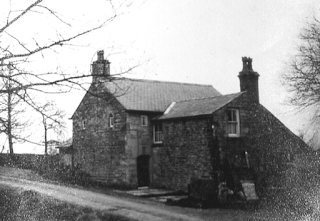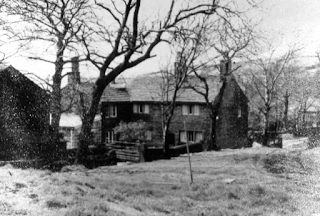Chapter VI - The Five Yeomen
The Mosleys originated in Moseley near Wolverhampton and in the 1400s a branch of the family established themselves at Hough End, Chorlton-cum-Hardy. During the next century Nicholas Mosley and his brother Anthony amassed great wealth as woollen merchants operating between Manchester and London. In 1595 Nicholas was knighted after serving as Lord Mayor of London and the following year, as noted in Chapter II, he bought the Manorial Rights of Manchester from his friend John Lacey for £3500.After the decline of feudalism many yeomen farmers had gained an important position in local society and started to purchase the properties in their possession. This appears to have been the situation in Harwood which led to an unusual sale of the total holdings of the Mosley family in the township. By an Indenture dated May 1st, 1612, Sir Nicholas Mosley and his son, Edward, the Attorney General of the Duchy of Lancaster, conveyed 'in consideration of eleven hundred pounds ... the manor or Lordship of Harwood with all ... messuages, mylles, tofts, crofts, cottages, lands, tenements, meadows, lesowes & pastures, commons, waste, woods, etc', to a partnership of five yeomen of Harwood.
This partnership, namely Matthew Harrison, Henry Haworth, Raufe Higson, Lawrence Horrocks and Edward Greenhalgh, was entrusted to convey the various tenements located in their 300 acre holding to the tenants in possession, including themselves. The tenants were to pay 'a rateable and proportional part of the purchase money if so minded' for acquisition of 'certain messuages and lands in the hands of occupiers ... their heirs and assigns shall at all times hereafter have hold and peacably and quietly enjoye the said messuage or tenement, land, etc'.
To summarise the above agreement, the leases to the occupiers were to be freehold and the proportional payments were apparently to be in ratio to the acreage of land held. They would hold a proportional part of the common land conveyed to the five yeoman subject to the 'estate rights and interests in to upon and out of the said waste grounds' of the commoners and be allotted a proportional part of the commons if at any time they were 'enclosed.' (ie legally partitioned and awarded to the principal land-holders - R3) They had 'rights of common' which included 'common of pasture' at all times for all manner of cattle and also 'common of turbary' to dig and carry away turfs, stone, slate, clay, marle, etc. If by general consent any 'pittes for getting stones, slates and coles' were to be dug in the commons, any profits would be proportioned amongst the leaseholders.
The trusteeship of five yeomen commenced the conveyancing of the various properties to the occupants eighteen months after their acquisition from the Mosleys and the transactions over the next few years are scheduled in Figure 13. The details of the first five conveyances listed have been obtained from existing deeds of which brief extracts follow.
LONGWORTHS FARM
Indenture of October 6th, 1613. The five yeomen conveyed to Henry Ashurst of Asheton (assignee for John Entwistle) 'a part of Harwood to John Entwistle of Entwistle for the sum of £113 being a rateable portion of the total sum of £1100'. Witnessed by Raufe Higson, Henry Haworth, Edward Greenhalghe, Lawrence Horrocks & Mathewe Haryson.(Lancashire Record Office Ref QDD 21/20)
 |
| Figure 15 Longworths Farm c1950. Occupied by three generations of the Longworth family from c1660 |
KNOTTS FARM (East & West)
Indenture of December 21st, 1613. Four of the five yeomen conveyed to the fifth yeoman, Henry Haworth 'for the sum of one hundred and three score pounds, being a proportional part of the said sum...messuage, howses, orchards, meadows, pastures, etc...in his tenure or occupation'. Witnessed by Raufe Higson, Edward Greenhalghe, Lawrence Horrocks & Mathewe Haryson. (the latter two witnesses made their mark)(Knotts Estate Papers. Mr John Calderbank)
 |
| Figure 17 Top o'th' Knotts (East). Front view from south. Occupied by William Haslam in the late 1500s. His widow, Elizabeth, married her neighbour Henry Howarth in 1607. |
BROOKFOLD (North)
Indenture of August 8th, 1615. The five yeomen conveyed to Giles Aynesworth of Aynesworth for a consideration of £38 'certain messuages and lands in the hands of occupiers named and a thirty-fifth part of the moors, commons, etc, belonging to the manor of Harwood'. Witnessed by Edward Bromiley, Edmund Brooke & John Brooke (Chethams Library. Hulme Deed 108) |
| Figure 19 Brookfold Farm (North). Occupied by Edmund Brooke in the 1500s but purchased by Giles Ainsworth in 1615. The Brookes 'recovered' the freehold from the Ainsworths in 1678. |
BROOKFOLD (South)
Indenture of January 1st 1616. The five yeomen conveyed an occupancy to 'John, son and heir of William Brooke of Harwood, yeoman, for a consideration of two and thirty pounds'. Witnessed by William Horrocks, Thomas Bromiley, John Crompton, Thomas Walch & Ellis Hardier.(Chethams Library. Hulme Deed 109)
 |
| Figure 22 Brookfold Farm (South). John Brooke, Edmund's brother, purchased the farm in 1615. William Hulme bought the freehold in 1664 but the Brookes remained in occupation. |
GREENHALGH FOLD
Indenture of August 20th, 1617. Four of the five yeomen conveyed 'for the sum of three score and fourteen pounds .being a proportionable part of the sum of eleven hundred pounds.in performance of the said trust.to the said Edward Greenhalgh.that messuage or tenement.and also the eighteenth part of the wastes and commons'. Witnessed by Raufe Higson, Henry Haworth, Lawrence Horrocks & Mathewe Haryson (Bolton Libraries. Archives Ref ZZ/52/1) |
| Figure 24 Greenhalgh Fold Held by the Greenhalgh family from as early as 1503. Purchased by John Hough in the mid-1700s when the name changed to Hough Fold. |
Schedule of Conveyances 1613 to c1620
 |
| Figure 13 - Schedule of Conveyances 1613 to c1620 Tenancies of the Five Yeomen indicated * |
Of the remaining conveyances, whilst no deeds are available, the identity of the tenants is generally indicated in other documents. The scheduled acreages have been measured from the available plans and the assessed costs are based on these acreages.
The freehold leases purchased by the occupiers would be 'for ever' without any stipulated end date and the estate could be disposed of without restriction. Conveyances were by Livery of Seison, which involved handing over part of the property (ie a turf) for an entry fee (quit rent) in the presence of witnesses. For safe remembrance the conveyances were normally recorded with an Indenture of Feoffment. This was a deed written twice (or more) on a single piece of parchment which was separated with indented (wavy) cuts and a part retained by each party. (A deed involving one party only had a straight or polled edge and was called a Deed Poll). Inheritance of the property would normally be to the heir apparent but if the descent was restricted to a particular person, the lease was said to be entailed and could not be sold.
Previous to the above restructuring the occupants had held their tenancies direct from the land-holders generally by leasehold for a limited number of years or lives. A lease granted for a specified period such as 99 or 999 years could be conditionally transferred to another person for the residue of the specified period. A lease granted for several lives (usually three relatives of the lessee) was almost equivalent to a freehold in that it had no definite end date. Normally the lease was allowed to continue until the death of the last surviving party and regranted with the inclusion of another nominated person.
Of these early tenancies it is known that Peter Greenhalgh held land from Edmund Trafford in 1523, John Bradshaw held land in the Riding Gate area valued at 3s 4d per annum from Sir Edmund Trafford in 1548, Edmund Brooke held the leasehold of Brookfold North for 80 years at 6s.8d per annum from Sir Nicholas Mosley in 1607 and Elizabeth Haslam held Top o'th' Knotts Farm (East) from Sir Nicholas Mosley in 1607.
Besides freehold and leasehold, a third form of estate lease in use at the time, but not applicable in the Manor of Manchester, was copyhold which was for property held by customary tenants of a manor. Title to the property was entered on the manor court rolls with a 'copy held' by the tenant. With these leases the tenant was not protected by common law and they were finally abolished by an Act of 1922 when existing copyholds were converted into freeholds. The only known local copyhold leases were in the neighbouring Manor of Tottington where the court rolls from 1504 to 1587 (R14) record numerous inquisitions into the registration and surrender of these leases by the customary tenants.